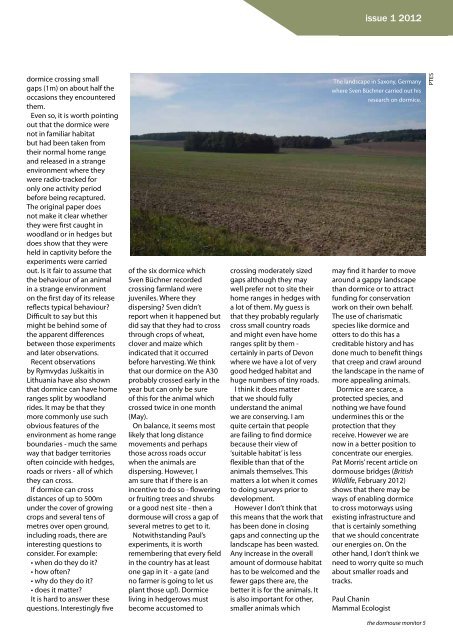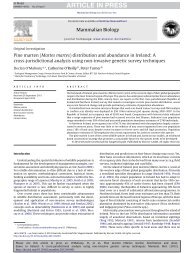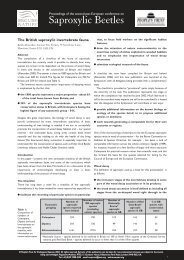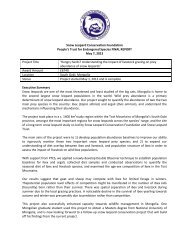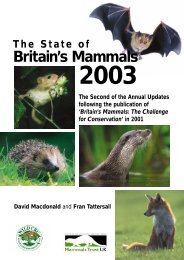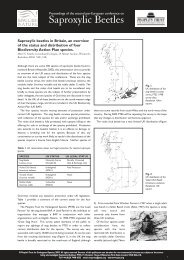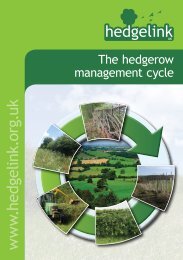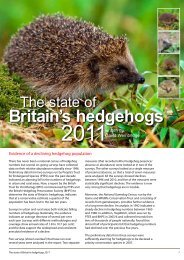The Dormouse Monitor vol 1 2012 - People's Trust for Endangered ...
The Dormouse Monitor vol 1 2012 - People's Trust for Endangered ...
The Dormouse Monitor vol 1 2012 - People's Trust for Endangered ...
Create successful ePaper yourself
Turn your PDF publications into a flip-book with our unique Google optimized e-Paper software.
issue 1 <strong>2012</strong>dormice crossing smallgaps (1m) on about half theoccasions they encounteredthem.Even so, it is worth pointingout that the dormice werenot in familiar habitatbut had been taken fromtheir normal home rangeand released in a strangeenvironment where theywere radio-tracked <strong>for</strong>only one activity periodbe<strong>for</strong>e being recaptured.<strong>The</strong> original paper doesnot make it clear whetherthey were first caught inwoodland or in hedges butdoes show that they wereheld in captivity be<strong>for</strong>e theexperiments were carriedout. Is it fair to assume thatthe behaviour of an animalin a strange environmenton the first day of its releasereflects typical behaviour?Difficult to say but thismight be behind some ofthe apparent differencesbetween those experimentsand later observations.Recent observationsby Rymvydas Juškaitis inLithuania have also shownthat dormice can have homeranges split by woodlandrides. It may be that theymore commonly use suchobvious features of theenvironment as home rangeboundaries - much the sameway that badger territoriesoften coincide with hedges,roads or rivers - all of whichthey can cross.If dormice can crossdistances of up to 500munder the cover of growingcrops and several tens ofmetres over open ground,including roads, there areinteresting questions toconsider. For example:• when do they do it?• how often?• why do they do it?• does it matter?It is hard to answer thesequestions. Interestingly fiveof the six dormice whichSven Büchner recordedcrossing farmland werejuveniles. Where theydispersing? Sven didn’treport when it happened butdid say that they had to crossthrough crops of wheat,clover and maize whichindicated that it occurredbe<strong>for</strong>e harvesting. We thinkthat our dormice on the A30probably crossed early in theyear but can only be sureof this <strong>for</strong> the animal whichcrossed twice in one month(May).On balance, it seems mostlikely that long distancemovements and perhapsthose across roads occurwhen the animals aredispersing. However, Iam sure that if there is anincentive to do so - floweringor fruiting trees and shrubsor a good nest site - then adormouse will cross a gap ofseveral metres to get to it.Notwithstanding Paul’sexperiments, it is worthremembering that every fieldin the country has at leastone gap in it - a gate (andno farmer is going to let usplant those up!). Dormiceliving in hedgerows mustbecome accustomed tocrossing moderately sizedgaps although they maywell prefer not to site theirhome ranges in hedges witha lot of them. My guess isthat they probably regularlycross small country roadsand might even have homeranges split by them -certainly in parts of Devonwhere we have a lot of verygood hedged habitat andhuge numbers of tiny roads.I think it does matterthat we should fullyunderstand the animalwe are conserving. I amquite certain that peopleare failing to find dormicebecause their view of‘suitable habitat’ is lessflexible than that of theanimals themselves. Thismatters a lot when it comesto doing surveys prior todevelopment.However I don’t think thatthis means that the work thathas been done in closinggaps and connecting up thelandscape has been wasted.Any increase in the overallamount of dormouse habitathas to be welcomed and thefewer gaps there are, thebetter it is <strong>for</strong> the animals. Itis also important <strong>for</strong> other,smaller animals which<strong>The</strong> landscape in Saxony, Germanywhere Sven Büchner carried out hisresearch on dormice.may find it harder to movearound a gappy landscapethan dormice or to attractfunding <strong>for</strong> conservationwork on their own behalf.<strong>The</strong> use of charismaticspecies like dormice andotters to do this has acreditable history and hasdone much to benefit thingsthat creep and crawl aroundthe landscape in the name ofmore appealing animals.Dormice are scarce, aprotected species, andnothing we have foundundermines this or theprotection that theyreceive. However we arenow in a better position toconcentrate our energies.Pat Morris’ recent article ondormouse bridges (BritishWildlife, February <strong>2012</strong>)shows that there may beways of enabling dormiceto cross motorways usingexisting infrastructure andthat is certainly somethingthat we should concentrateour energies on. On theother hand, I don’t think weneed to worry quite so muchabout smaller roads andtracks.Paul ChaninMammal EcologistPTESthe dormouse monitor 5


